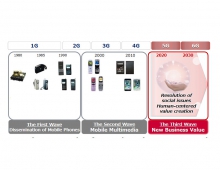
DOCOMO Achieves First 10 Gbps Packet Transmission in Outdoor Experiment
In a joint outdoor experiment conducted recently with the Tokyo Institute of Technology, Japans mobile operator NTT DOCOMO succeeded in the first packet transmission uplink rate of approximately 10 Gbps.
The test, which is expected to help pave the way for future super-high-bit-rate mobile communications, took place in Ishigaki City of Okinawa Prefecture, Japan on December 11, 2012.
In the experiment, a 400 MHz bandwidth in the 11 GHz spectrum was transmitted from a mobile station moving at approximately 9 km/h. Multiple-input multiple-output (MIMO) technology was used to spatially multiplex different data streams using 8 transmitting antennas and 16 receiving antennas on the same frequency.
In light of the squeeze on remaining frequencies as mobile data traffic continues to increase, DOCOMO aims to achieve a transmission speed of more than 10 Gbps using super-high-frequency bands exceeding 5 GHz. Such high frequencies have been difficult to use for mobile networks due to the limited distances their waves are able to travel, especially along indirect paths such as around buildings. This is why more robust lower-frequency waves have been the preferred choice for mobile communications systems so far.
Detailed findings of the experiment were presented to the Technical Committee on Radio Communication Systems of the Institute of Electronics, Information and Communication Engineers at Waseda University in Tokyo from February 27.
The technologies behind the experiment also are applicable to downlink packet transmissions, suggesting that it should be possible to achieve a 10Gbps downlink, which is one hundred times the 100Mbps maximum rate of DOCOMOs current Xi LTE service.
In the experiment, a 400 MHz bandwidth in the 11 GHz spectrum was transmitted from a mobile station moving at approximately 9 km/h. Multiple-input multiple-output (MIMO) technology was used to spatially multiplex different data streams using 8 transmitting antennas and 16 receiving antennas on the same frequency.
In light of the squeeze on remaining frequencies as mobile data traffic continues to increase, DOCOMO aims to achieve a transmission speed of more than 10 Gbps using super-high-frequency bands exceeding 5 GHz. Such high frequencies have been difficult to use for mobile networks due to the limited distances their waves are able to travel, especially along indirect paths such as around buildings. This is why more robust lower-frequency waves have been the preferred choice for mobile communications systems so far.
Detailed findings of the experiment were presented to the Technical Committee on Radio Communication Systems of the Institute of Electronics, Information and Communication Engineers at Waseda University in Tokyo from February 27.
The technologies behind the experiment also are applicable to downlink packet transmissions, suggesting that it should be possible to achieve a 10Gbps downlink, which is one hundred times the 100Mbps maximum rate of DOCOMOs current Xi LTE service.


















